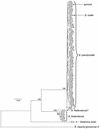Multilocus sequence typing and evolutionary relationships among the causative agents of melioidosis and glanders, Burkholderia pseudomallei and Burkholderia mallei
- PMID: 12734250
- PMCID: PMC154742
- DOI: 10.1128/JCM.41.5.2068-2079.2003
Multilocus sequence typing and evolutionary relationships among the causative agents of melioidosis and glanders, Burkholderia pseudomallei and Burkholderia mallei
Erratum in
- J Clin Microbiol. 2003 Oct;41(10):4913
Abstract
A collection of 147 isolates of Burkholderia pseudomallei, B. mallei, and B. thailandensis was characterized by multilocus sequence typing (MLST). The 128 isolates of B. pseudomallei, the causative agent of melioidosis, were obtained from diverse geographic locations, from humans and animals with disease, and from the environment and were resolved into 71 sequence types. The utility of the MLST scheme for epidemiological investigations was established by analyzing isolates from captive marine mammals and birds and from humans in Hong Kong with melioidosis. MLST gave a level of resolution similar to that given by pulsed-field gel electrophoresis and identified the same three clones causing disease in animals, each of which was also associated with disease in humans. The average divergence between the alleles of B. thailandensis and B. pseudomallei was 3.2%, and there was no sharing of alleles between these species. Trees constructed from differences in the allelic profiles of the isolates and from the concatenated sequences of the seven loci showed that the B. pseudomallei isolates formed a cluster of closely related lineages that were fully resolved from the cluster of B. thailandensis isolates, confirming their separate species status. However, isolates of B. mallei, the causative agent of glanders, recovered from three continents over a 30-year period had identical allelic profiles, and the B. mallei isolates clustered within the B. pseudomallei group of isolates. Alleles at six of the seven loci in B. mallei were also present within B. pseudomallei isolates, and B. mallei is a clone of B. pseudomallei that, on population genetics grounds, should not be given separate species status.
Figures




Similar articles
-
A Quadruplex Real-Time PCR Assay for the Rapid Detection and Differentiation of the Most Relevant Members of the B. pseudomallei Complex: B. mallei, B. pseudomallei, and B. thailandensis.PLoS One. 2016 Oct 13;11(10):e0164006. doi: 10.1371/journal.pone.0164006. eCollection 2016. PLoS One. 2016. PMID: 27736903 Free PMC article.
-
Detection and differentiation of Burkholderia pseudomallei, Burkholderia mallei and Burkholderia thailandensis by multiplex PCR.FEMS Immunol Med Microbiol. 2005 Mar 1;43(3):413-7. doi: 10.1016/j.femsim.2004.10.008. FEMS Immunol Med Microbiol. 2005. PMID: 15708316
-
Burkholderia humptydooensis sp. nov., a New Species Related to Burkholderia thailandensis and the Fifth Member of the Burkholderia pseudomallei Complex.Appl Environ Microbiol. 2017 Feb 15;83(5):e02802-16. doi: 10.1128/AEM.02802-16. Print 2017 Mar 1. Appl Environ Microbiol. 2017. PMID: 27986727 Free PMC article.
-
PCR-based Methodologies Used to Detect and Differentiate the Burkholderia pseudomallei complex: B. pseudomallei, B. mallei, and B. thailandensis.Curr Issues Mol Biol. 2014;16:23-54. Epub 2013 Aug 22. Curr Issues Mol Biol. 2014. PMID: 23969318 Review.
-
[Molecular-genetic approaches to diagnosis and intraspecific typing of causative agents of glanders and melioidosis].Mol Gen Mikrobiol Virusol. 2005;(2):3-9. Mol Gen Mikrobiol Virusol. 2005. PMID: 15954468 Review. Russian.
Cited by
-
Melioidosis as a consequence of sporting activity.Am J Trop Med Hyg. 2013 Aug;89(2):365-6. doi: 10.4269/ajtmh.12-0744. Epub 2013 Jun 3. Am J Trop Med Hyg. 2013. PMID: 23732257 Free PMC article.
-
Early Activation of iNKT Cells Increased Survival Time of BALB/c Mice in a Murine Model of Melioidosis.Infect Immun. 2022 Dec 15;90(12):e0026822. doi: 10.1128/iai.00268-22. Epub 2022 Nov 14. Infect Immun. 2022. PMID: 36374098 Free PMC article.
-
Sequence-based detection and typing procedures for Burkholderia mallei: Assessment and prospects.Front Vet Sci. 2022 Nov 14;9:1056996. doi: 10.3389/fvets.2022.1056996. eCollection 2022. Front Vet Sci. 2022. PMID: 36452150 Free PMC article. Review.
-
Multilocus sequence typing scheme that provides both species and strain differentiation for the Burkholderia cepacia complex.J Clin Microbiol. 2005 Sep;43(9):4665-73. doi: 10.1128/JCM.43.9.4665-4673.2005. J Clin Microbiol. 2005. PMID: 16145124 Free PMC article.
-
Emergence of pediatric melioidosis in Siem Reap, Cambodia.Am J Trop Med Hyg. 2010 Jun;82(6):1106-12. doi: 10.4269/ajtmh.2010.10-0030. Am J Trop Med Hyg. 2010. PMID: 20519608 Free PMC article.
References
-
- Abbink, F. C., J. M. Orendi, and A. J. de Beaufort. 2001. Mother-to-child transmission of Burkholderia pseudomallei. N. Engl. J. Med. 344:1171-1172. - PubMed
-
- Brett, P. J., D. DeShazer, and D. E. Woods. 1998. Burkholderia thailandensis sp. nov., a Burkholderia pseudomallei-like species. Int. J. Syst. Bacteriol. 48:317-320. - PubMed
-
- Currie, B. J., M. Mayo, N. M. Anstey, P. Donohoe, A. Haase, and D. J. Kemp. 2001. A cluster of melioidosis cases from an endemic region is clonal and is linked to the water supply using molecular typing of Burkholderia pseudomallei isolates. Am. J. Trop. Med. Hyg. 65:177-179. - PubMed
Publication types
MeSH terms
Substances
Grants and funding
LinkOut - more resources
Full Text Sources
Other Literature Sources
Molecular Biology Databases

